Discrete Environment-Driven GPU-Based Ray Launching: Validation and Applications
Abstract
:1. Introduction
2. The DED-RL Algorithm
2.1. Environment-Driven RL
2.2. Discrete RL
2.3. Visibility Preprocessing
2.4. Field Computation
2.5. GPU Parallelization
2.6. Further Extensions to the DED-RL Algorithm
- efficient Over-Rooftop (ORT) propagation through multiple diffractions over building rooftops;
- attenuation through vegetation;
- transmission through buildings at a limited extent, considering only the closest building to the Base Station (BS).
3. Validation
3.1. Measurement Campaigns
3.2. Validation of the DED-RL Algorithm
3.2.1. Comparison between DED-RL and RT
3.2.2. Computation Time in the San Francisco Scenario
3.2.3. Results for San José and Atlanta
3.2.4. Wideband Results
4. Application Prospects
4.1. Application to UAV-Aided Wireless Networks
4.2. Application to Fingerprinting Localization
- Fingerprint density: How dense should the discretization for ray launching simulation be? There are computation time and memory storage concerns for greater densities. The use of very efficient algorithms such as DED-RL is mandatory to ease this problem.
- Fingerprint measurement types: The predicted rays from ray launching need to be further processed into emulated radio measurements. These measurements should be consistent with those available from the target radio standard. For example, in 3GPP Rel 16 [38], there are a variety of measurements introduced for positioning, which generally fall in the following categories: RSS, ToA, Direction of Arrival/Departure (DoA/DoD).
- Fingerprinting localization algorithm: How to fuse different measurements and compare them to the database of fingerprints in a way that is consistent with the propagation physics? The foregoing problem need to be properly addressed to make fingerprinting localization unfold its potential.
5. Conclusions
Author Contributions
Funding
Institutional Review Board Statement
Informed Consent Statement
Data Availability Statement
Acknowledgments
Conflicts of Interest
References
- Balanis, C. Advanced Engineering Electromagnetics; Wiley: Hoboken, NJ, USA, 1989. [Google Scholar]
- Kouyoumjian, R.G.; Pathak, P.H. A uniform GTD for an edge in a perfectly conducting surface. Proc. IEEE 1974, 62, 1448–1461. [Google Scholar] [CrossRef] [Green Version]
- Yun, Z.; Iskander, M.F. Ray Tracing for Radio Propagation Modeling: Principles and Applications. IEEE Access 2015, 3, 1089–1100. [Google Scholar] [CrossRef]
- Bertoni, H.L. Radio Propagation for Modern Wireless Systems; Prentice Hall: Upper Saddle River, NJ, USA, 2000. [Google Scholar]
- Corre, Y.; Lostanlen, Y. Three-Dimensional Urban EM Wave Propagation Model for Radio Network Planning and Optimization Over Large Areas. IEEE Trans. Veh. Technol. 2009, 58, 3112–3123. [Google Scholar] [CrossRef]
- Vitucci, E.M.; Degli-Esposti, V.; Fuschini, F.; Lu, J.S.; Barbiroli, M.; Wu, J.N.; Zoli, M.; Zhu, J.J.; Bertoni, H.L. Ray Tracing RF Field Prediction: An Unforgiving Validation. Int. J. Antennas Propag. 2015, 2015, 184608. [Google Scholar] [CrossRef] [Green Version]
- Rossi, J.-P.; Gabillet, Y. A mixed ray launching/tracing method for full 3-D UHF propagation modeling and comparison with wideband measurements. IEEE Trans. Antennas Propag. 2002, 50, 517–523. [Google Scholar] [CrossRef]
- Corre, Y.; Lostanlen, Y.; Le Helloco, Y. A new approach for radio propagation modeling in urban environment: Knife-edge diffraction combined with 2D ray-tracing. In Proceedings of the 55th IEEE Vehicular Technology Conference (VTC Spring 2002), Birmingham, AL, USA, 6–9 May 2002. [Google Scholar]
- Liang, G.; Bertoni, H.L. A new approach to 3-D ray tracing for propagation prediction in cities. IEEE Trans. Antennas Propag. 1998, 46, 853–863. [Google Scholar] [CrossRef] [Green Version]
- Hoppe, R.; Woelfle, G.; Wertz, P. Advanced ray-optical wave propagation modelling for urban and indoor scenarios. Eur. Trans. Telecommun. 2003, 14, 61–69. [Google Scholar] [CrossRef]
- Degli-Esposti, V.; Fuschini, F.; Vitucci, E.M.; Falciasecca, G. Speed-up techniques for ray tracing field prediction models. IEEE Trans. Antennas Propag. 2009, 57, 1469–1480. [Google Scholar] [CrossRef]
- He, D.; Ai, B.; Guan, K.; Wang, L.; Zhong, Z.; Kürner, T. The Design and Applications of High-Performance Ray-Tracing Simulation Platform for 5G and Beyond Wireless Communications: A Tutorial. IEEE Commun. Surv. Tutor. 2018, 21, 10–27. [Google Scholar] [CrossRef]
- Amich, M.; De Luca, P.; Fiscale, S. Accelerated implementation of FQSqueezer novel genomic compression method. In Proceedings of the 19th IEEE International Symposium on Parallel and Distributed Computing (ISPDC), Warsaw, Poland, 5–8 July 2020; pp. 158–163. [Google Scholar]
- De Luca, P.; Galletti, A.; Giunta, G.; Marcellino, L. Recursive filter based GPU algorithms in a Data Assimilation scenario. Elsevier J. Comput. Sci. 2021, 53, 101339. [Google Scholar]
- Liu, F.; Jansson, N.; Podobas, A.; Fredriksson, A.; Markidis, S. Accelerating Radiation Therapy Dose Calculation with Nvidia GPUs. arXiv 2021, arXiv:2103.09683. [Google Scholar]
- Tao, Y.; Lin, H.; Bao, H. GPU-Based Shooting and Bouncing Ray Method for Fast RCS Prediction. IEEE Trans. Antennas Propag. 2010, 58, 494–502. [Google Scholar]
- Schiller, M.; Knoll, A.; Mocker, M.; Eibert, T. GPU accelerated ray launching for high-fidelity virtual test drives of VANET applications. In Proceedings of the 2015 International Conference on High Performance Computing & Simulation (HPCS), Amsterdam, The Netherlands, 20–24 July 2015; pp. 262–268. [Google Scholar]
- Tan, J.; Su, Z.; Long, Y. A Full 3-D GPU-based Beam-Tracing Method for Complex Indoor Environments Propagation Modeling. IEEE Trans. Antennas Propag. 2015, 63, 2705–2718. [Google Scholar] [CrossRef]
- Dai, Z.; Watson, R.J. Accelerating a ray launching model using GPU with CUDA. In Proceedings of the 12th European Conference on Antennas and Propagation (EuCAP 2018), London, UK, 9–13 April 2018. [Google Scholar]
- Degli-Esposti, V.; Lu, J.S.; Vitucci, E.M.; Fuschini, F.; Barbiroli, M.; Blaha, J.; Bertoni, H.L. Efficient RF Coverage Prediction through a fully Discrete, GPU-Parallelized Ray-Launching model. In Proceedings of the 12th European Conference on Antennas and Propagation (EuCAP 2018), London, UK, 9–13 April 2018. [Google Scholar]
- Lu, J.S.; Vitucci, E.M.; Degli-Esposti, V.; Fuschini, F.; Barbiroli, M.; Blaha, J.; Bertoni, H.L. A Discrete Environment-Driven GPU-Based Ray Launching Algorithm. IEEE Trans. Antennas Propag. 2019, 67, 1558–2221. [Google Scholar] [CrossRef]
- Egea-Lopez, E.; Losilla, F.; Pascual-Garcia, J.; Molina-Garcia-Pardo, J.-M. Vehicular Networks Simulation with Realistic Physics. IEEE Access 2019, 7, 44021–44036. [Google Scholar] [CrossRef]
- Arpaio, M.J.; Vitucci, E.M.; Barbiroli, M.; Degli-Esposti, V.; Masotti, D.; Fuschini, F. A Multi-Frequency Investigation of Air-To-Ground Urban Propagation Using a GPU-based Ray Launching Algorithm. IEEE Access 2021, 9, 54407–54419. [Google Scholar] [CrossRef]
- Mignardi, S.; Arpaio, M.J.; Buratti, C.; Vitucci, E.M.; Fuschini, F.; Verdone, R. Performance Evaluation of UAV-Aided Mobile Networks by Means of Ray Launching Generated REMs. In Proceedings of the 30th International Telecommunication Networks and Applications Conference (ITNAC 2020), Melbourne, Australia, 25–27 November 2020. [Google Scholar]
- Järveläinen, J.; Haneda, K.; Karttunen, A. Indoor Propagation Channel Simulations at 60 GHz Using Point Cloud Data. IEEE Trans. Antennas Propag. 2016, 64, 4457–4467. [Google Scholar] [CrossRef]
- Pang, M.; Wang, H.; Lin, K.; Lin, H. A GPU-Based Radio Wave Propagation Prediction with Progressive Processing on Point Cloud. IEEE Antennas Wirel. Propag. Lett. 2021, 20, 1078–1082. [Google Scholar] [CrossRef]
- Degli-Esposti, V.; Fuschini, F.; Vitucci, E.M.; Falciasecca, G. Measurement and modelling of scattering from buildings. IEEE Trans. Antennas Propag. 2007, 55, 143–153. [Google Scholar] [CrossRef]
- Degli-Esposti, V.; Kolmonen, V.-M.; Vitucci, E.M.; Fuschini, F.; Vainikainen, P. Analysis and ray tracing modelling of co- and cross-polarization radio propagation in urban environment. In Proceedings of the 2nd European Conference on Antennas and Propagation (EuCAP 2007), Edinburgh, UK, 11–18 November 2007. [Google Scholar]
- Soyata, T. GPU Parallel Program Development Using CUDA; CRC Press: Boca Raton, FL, USA, 2018. [Google Scholar]
- Vitucci, E.M.; Degli-Esposti, V.; Mani, F.; Fuschini, F.; Barbiroli, M.; Gan, M.; Li, C.; Zhao, J.; Zhong, Z. Tuning Ray Tracing for Mm-wave Coverage Prediction in Outdoor Urban Scenarios. Radio Sci. 2019, 54, 1112–1128. [Google Scholar] [CrossRef]
- Degli-Esposti, V.; Falciasecca, G.; Fuschini, F.; Vitucci, E.M. A meaningful indoor path-loss formula. IEEE Antennas Wirel. Propag. Lett. 2013, 12, 872–875. [Google Scholar] [CrossRef]
- Degli-Esposti, V.; Lu, J.S.; Wu, J.N.; Zhu, J.J.; Blaha, J.A.; Vitucci, E.M.; Fuschini, F.; Barbiroli, M. A Semi-Deterministic Model for Outdoor-to-Indoor Prediction in Urban Areas. IEEE Antennas Wirel. Propag. Lett. 2017, 16, 2412–2415. [Google Scholar] [CrossRef]
- 3GPP. Evolved Universal Terrestrial Radio Access (E-UTRA): Physical Layer Procedures; Document TS36.213 V9.0.1; 3GPP: 2010. Available online: https://www.etsi.org/deliver/etsi_ts/136200_136299/136213/09.00.01_60/ts_136213v090001p.pdf (accessed on 15 March 2021).
- Zeng, Y.; Zhang, R.; Lim, T.J. Wireless Communications with Unmanned Aerial Vehicles: Opportunities and Challenges. IEEE Commun. Mag. 2016, 54, 36–42. [Google Scholar] [CrossRef] [Green Version]
- Mohammed, F.; Idries, A.; Mohamed, N.; Al-Jaroodi, J.; Jawhar, I. UAVs for smart cities: Opportunities and challenges. In Proceedings of the 2014 International Conference on Unmanned Aircraft Systems (ICUAS), Orlando, FL, USA, 27–30 May 2014; pp. 267–273. [Google Scholar]
- Li, J.; Lu, I.; Lu, J.S. Hybrid Fingerprinting and Ray Extension Localization in NLOS Regions, Part I: Algorithm Development. Unpublished work. 2021. [Google Scholar]
- Vo, Q.D.; De, P. A survey of fingerprint-based outdoor localization. IEEE Commun. Surv. Tutor. 2015, 18, 491–506. [Google Scholar] [CrossRef]
- 3GPP. Stage 2 Functional Specification of User Equipment (UE) Positioning in NG-RAN, 3rd ed.; Version 16.3.0. TS 38.305; Generation Partnership Project (3GPP): 2020. Available online: https://www.3gpp.org/ftp//Specs/archive/38_series/38.305/38305-g30.zip (accessed on 15 March 2021).
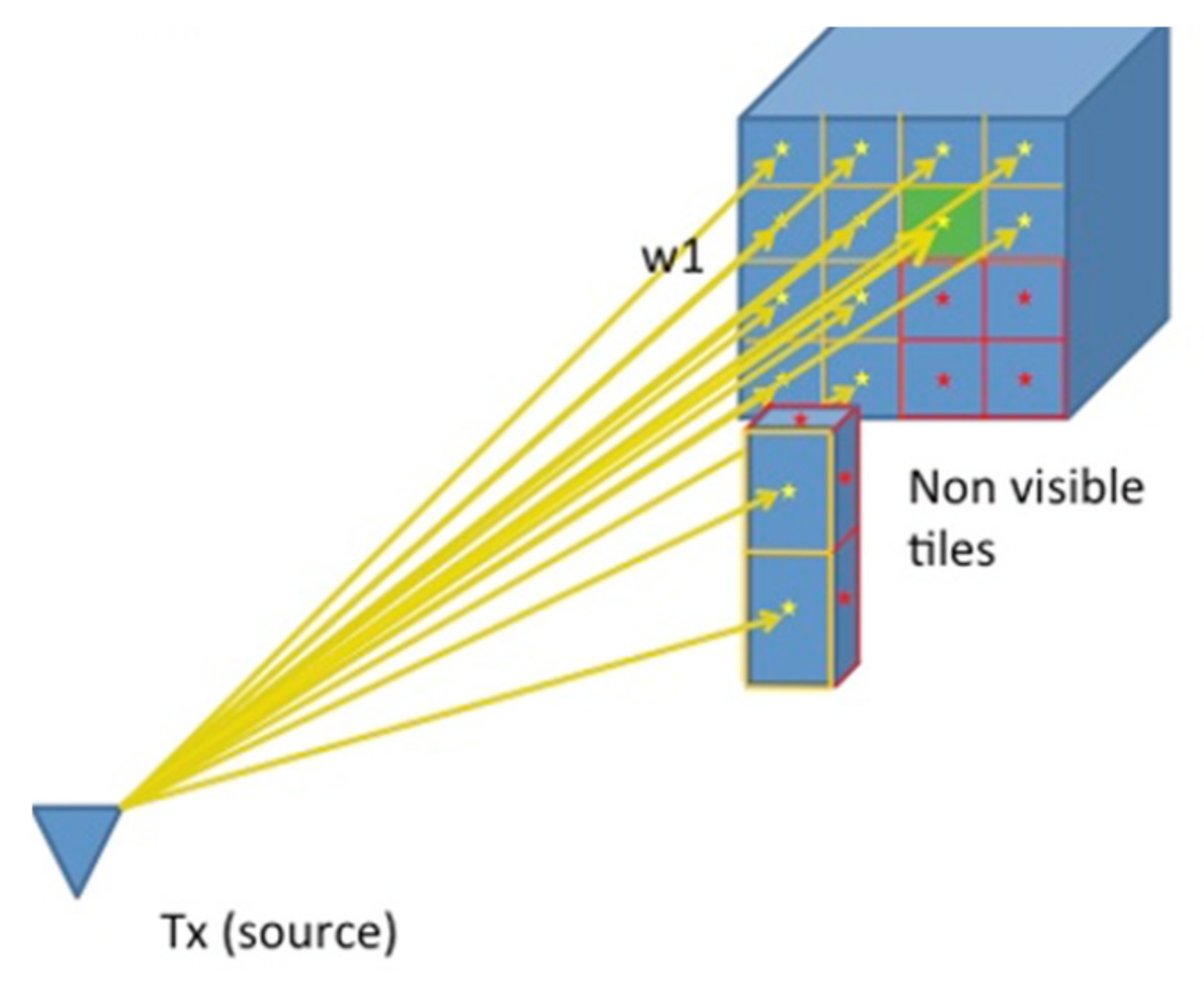
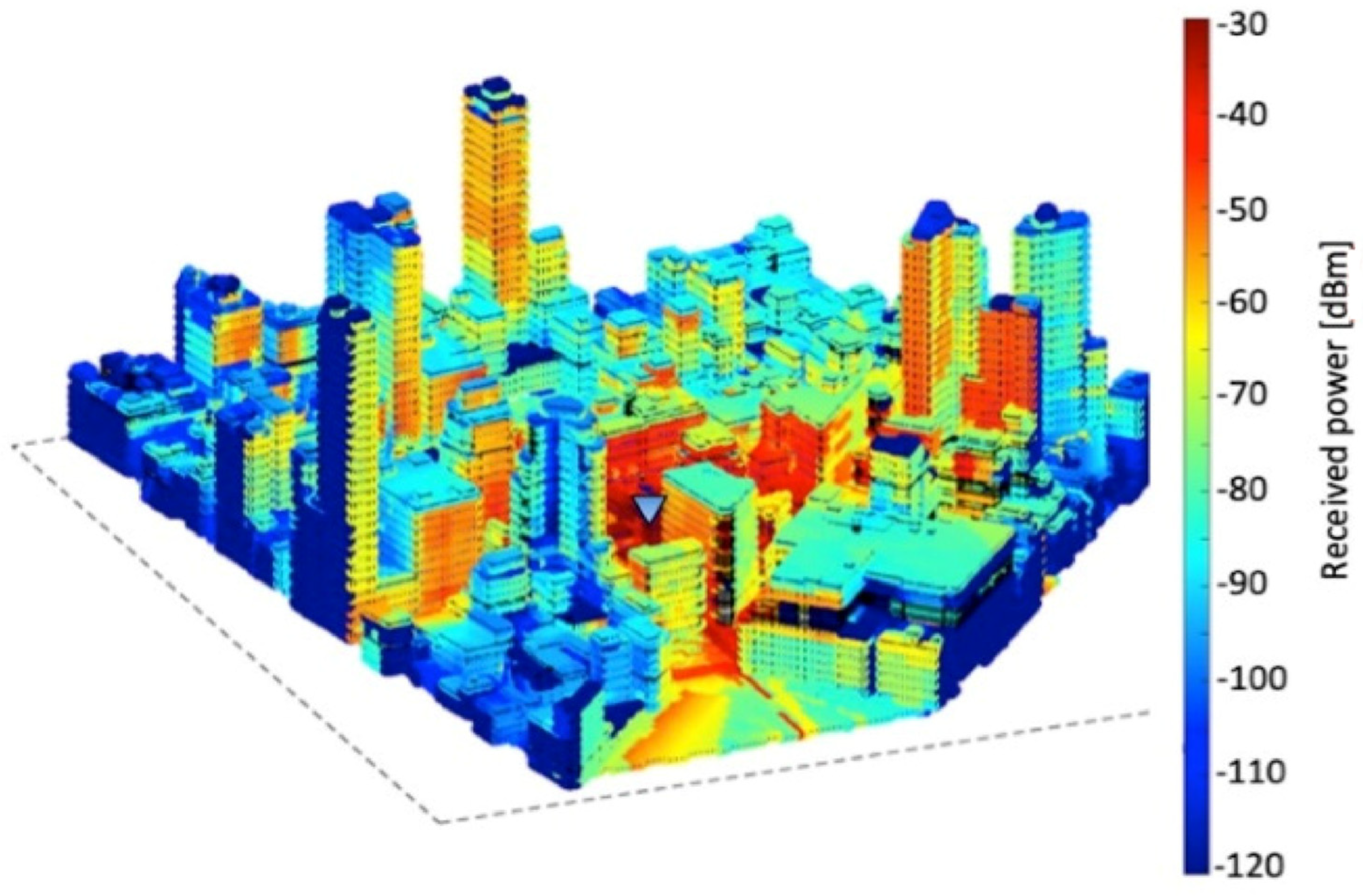
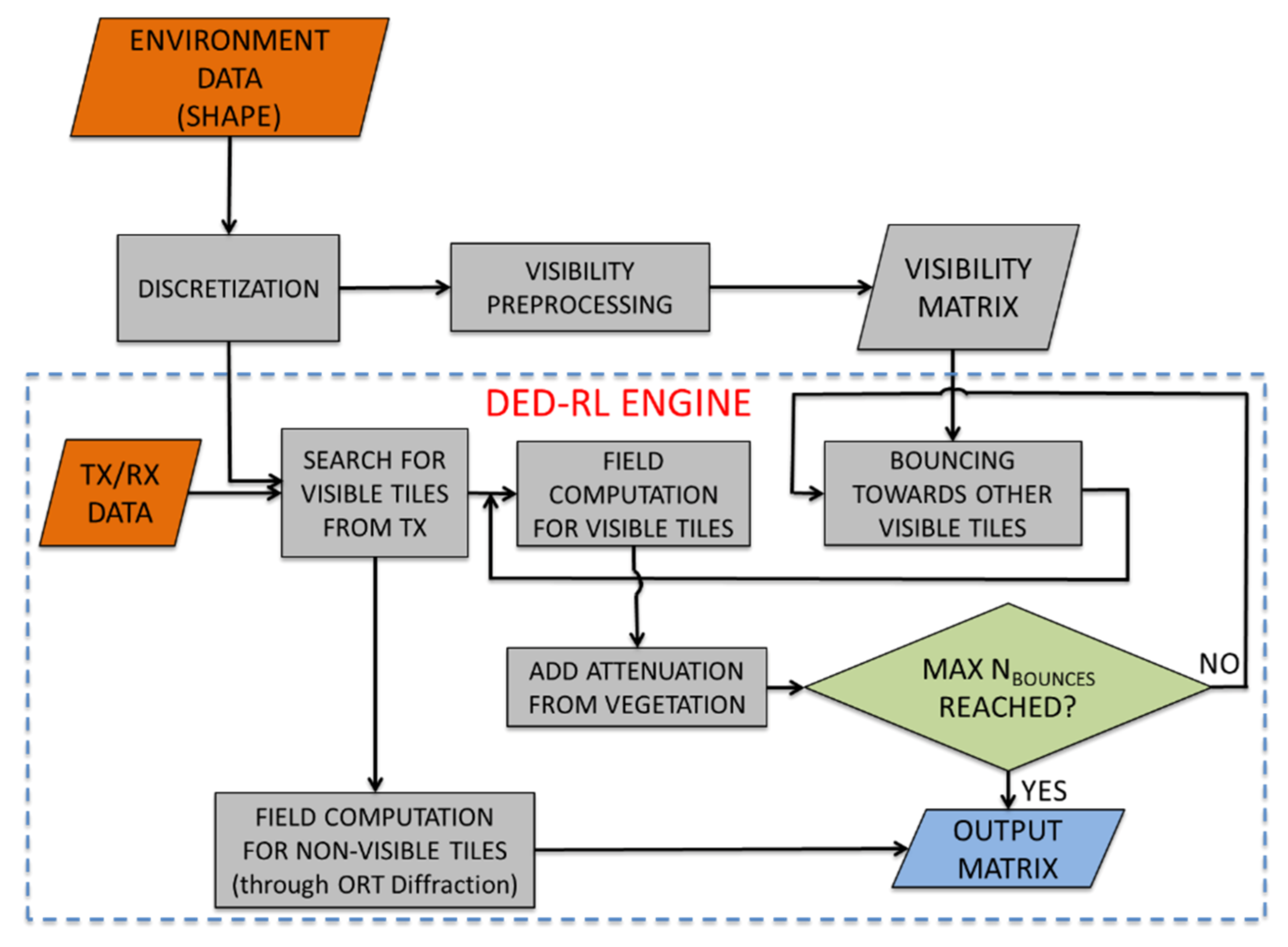
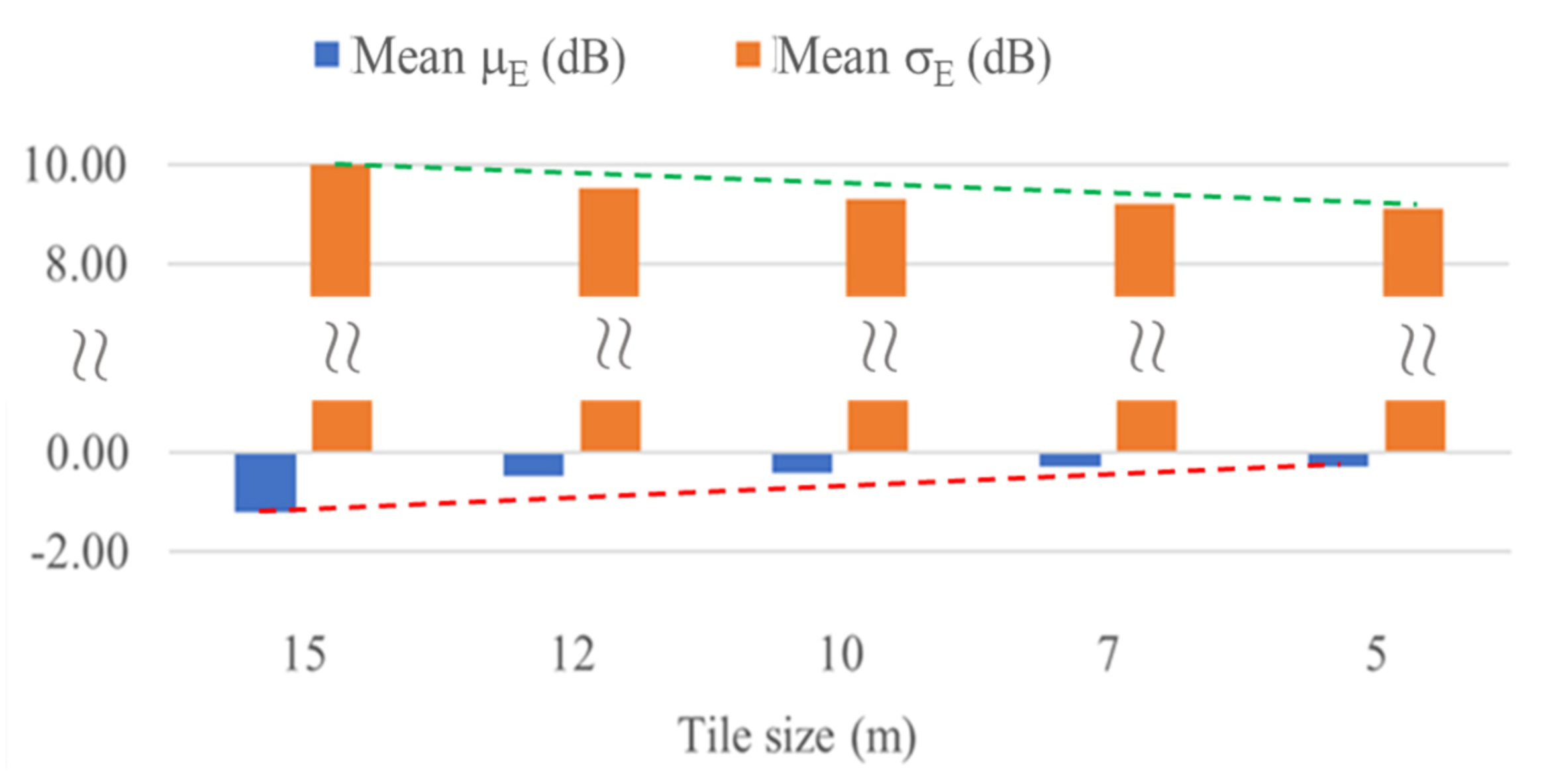
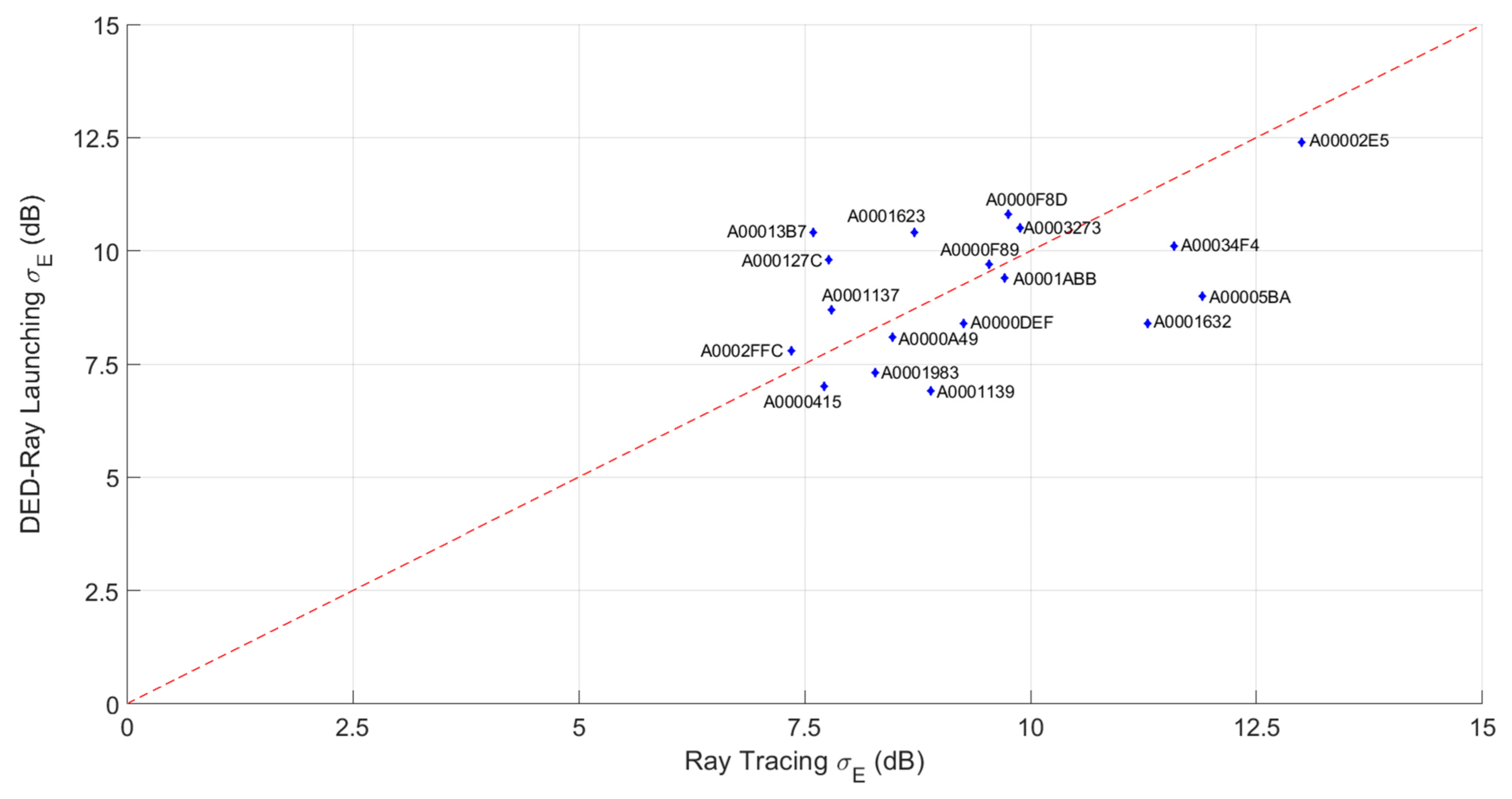
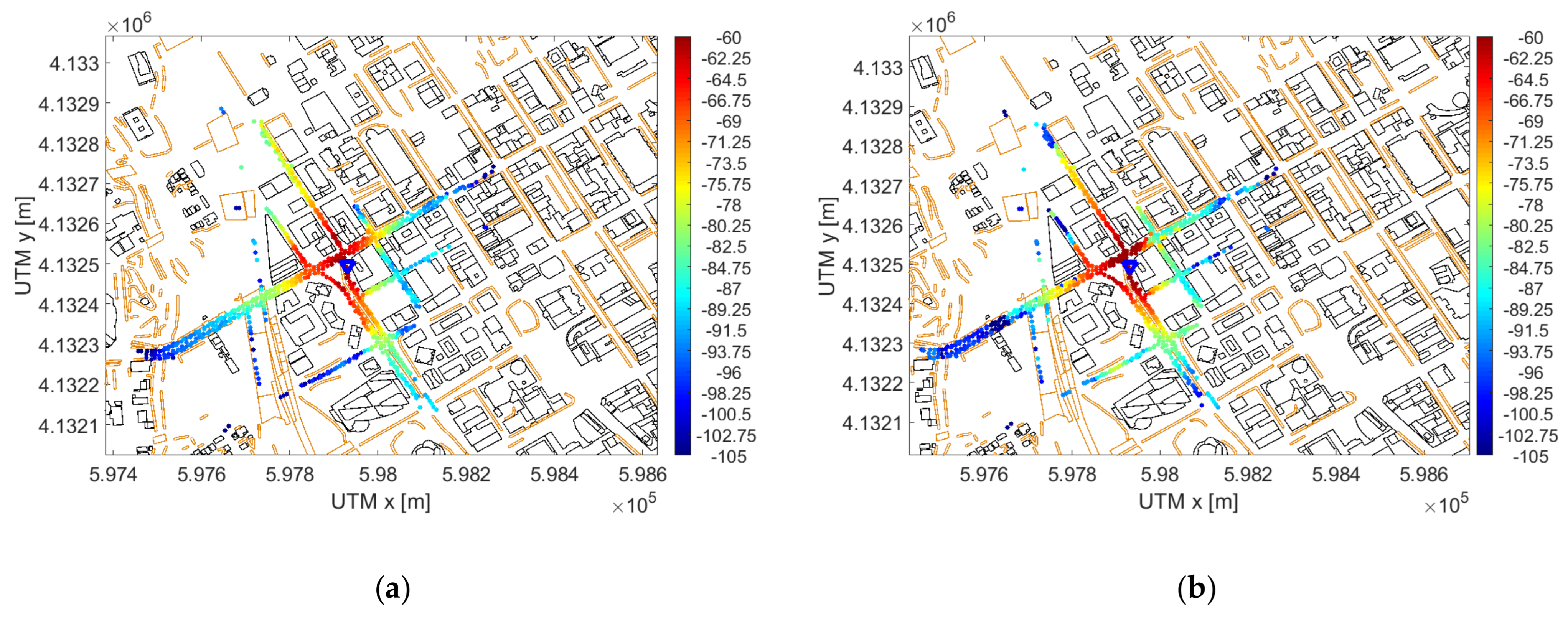
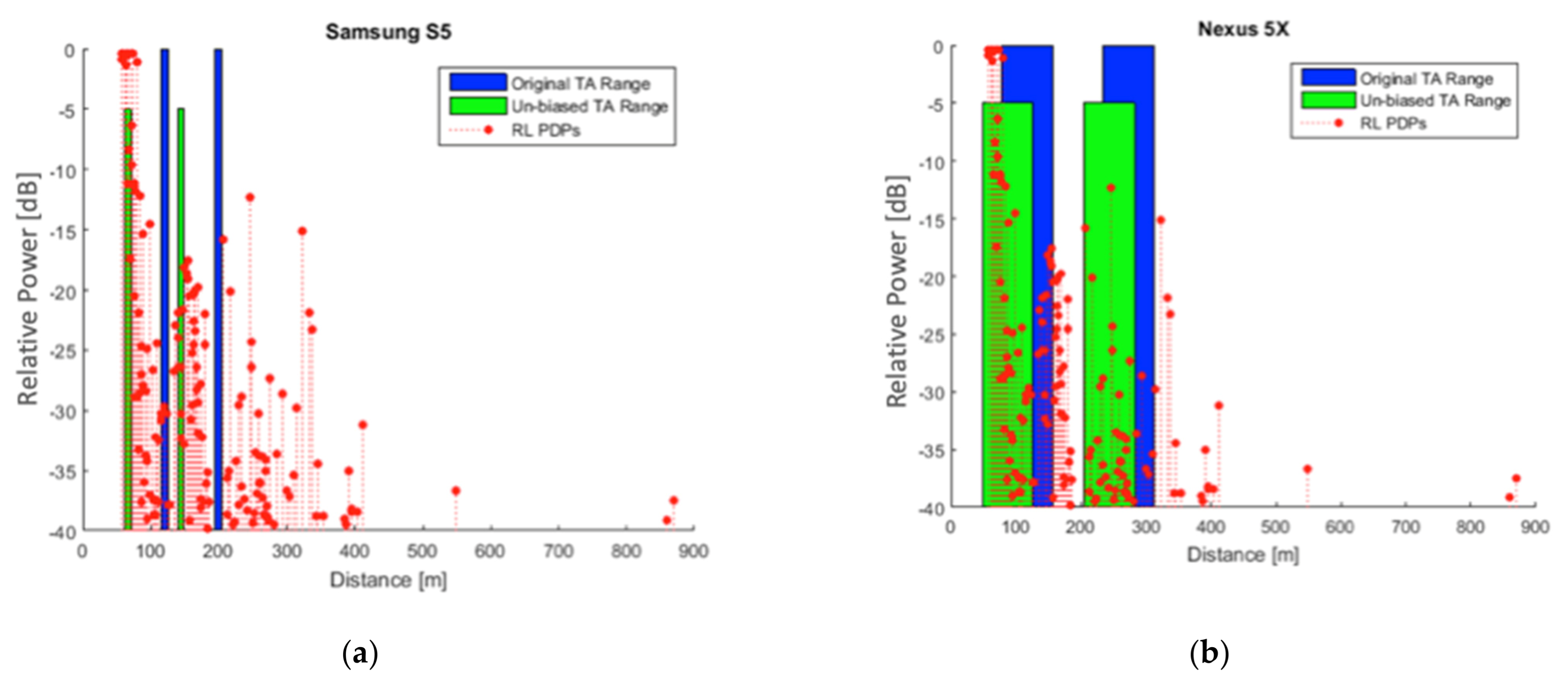
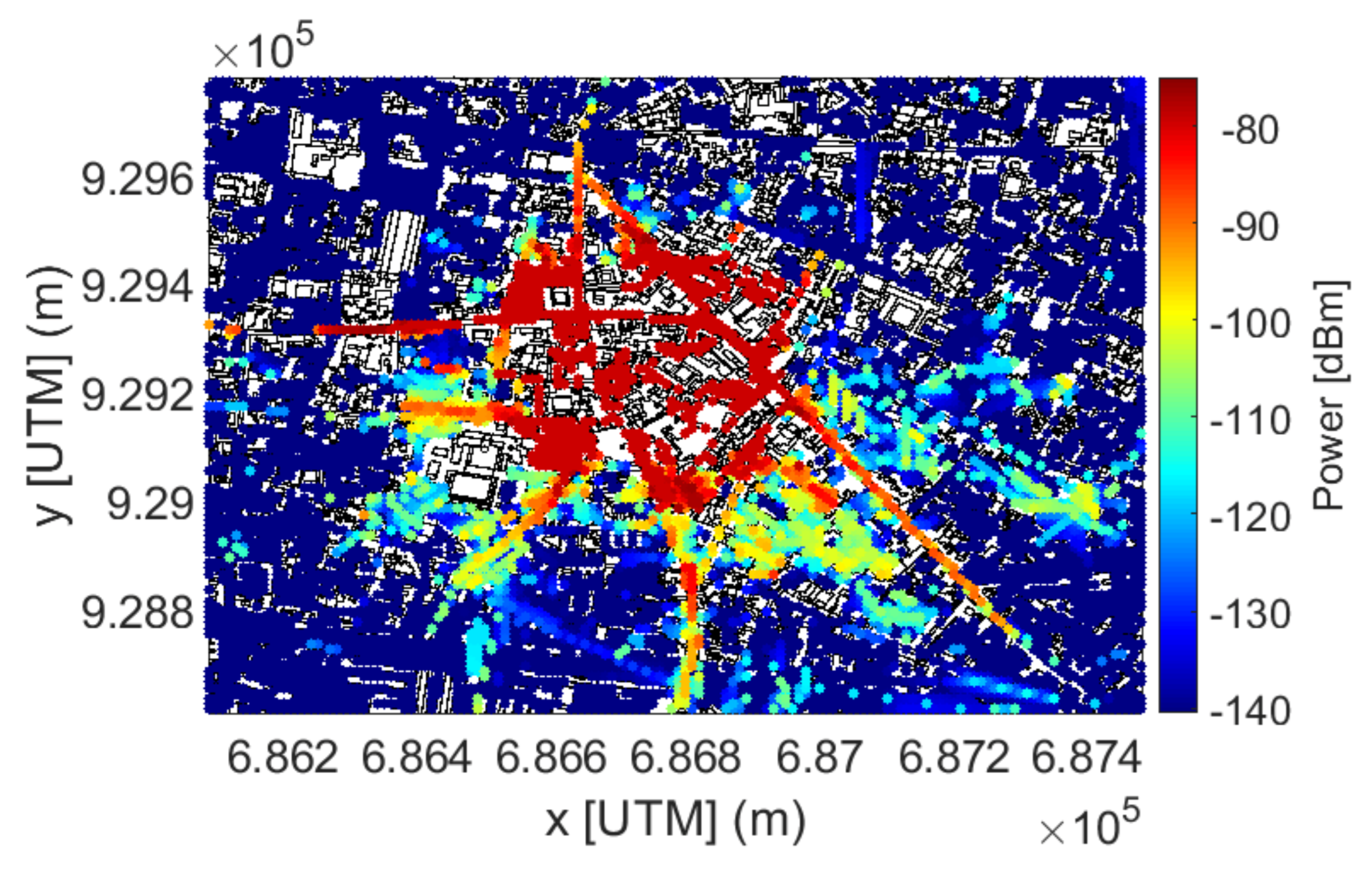
| Parameter | Value |
|---|---|
| Max. Number of interactions | 5 bounces: 5 reflections, 2 diffractions, 1 scattering |
| Max. Number of combined interactions | 3 among reflections and diffractions, 3 among diffractions and scattering |
| Over-Rooftop (ORT) diffraction enabled | Enabled |
| Combination of single reflection and scattering with ORT | Enabled 1 |
| Attenuation from vegetation | Enabled 1 |
| Transmission through the closest building to BS | Enabled 1 |
| Diffuse scattering coefficient (S) | 0.4 |
| Wall relative permittivity | 5 |
| Wall conductivity | 0.01 S/m |
| Scattering coefficient | 0.5 |
| Specific Attenuation through vegetation | 0.04 dB/m |
| Metric | SCENARIO | |
|---|---|---|
| San Francisco (DED-RL) | San Francisco (RT reference) | |
| Frequency | 850 and 1900 MHz | |
| Mean μE [dB] | 0.1 | −1.2 |
| St.dev. of μE [dB] | 5 | 3.6 |
| Mean σE [dB] | 9.0 | 9.3 |
| St.dev. of σE [dB] | 1.6 | 1.6 |
| DED-RL (Full Map) | Ray Tracing (Full Map) | DED-RL (Simplified Map) | RAY Tracing (Simplified Map) |
|---|---|---|---|
| 212 s | 302,400 s | 145 s | 36,000 s |
| Metric | SCENARIO | ||
|---|---|---|---|
| San José | North Atlanta | South Atlanta | |
| Frequency | 850 and 1900 MHz | ||
| N. of cell sites (4G) | 79 | 63 | 331 |
| Mean μE [dB] (before unbiasing) | 8.4 | 6.8 | 11.7 |
| Std. dev. of μE [dB] (before unbiasing) | 8.3 | 8.2 | 7.4 |
| Mean σE [dB] | 6.9 | 8.1 | 8.4 |
| Std. dev. of σE [dB] | 2.2 | 1.8 | 2.3 |
Publisher’s Note: MDPI stays neutral with regard to jurisdictional claims in published maps and institutional affiliations. |
© 2021 by the authors. Licensee MDPI, Basel, Switzerland. This article is an open access article distributed under the terms and conditions of the Creative Commons Attribution (CC BY) license (https://creativecommons.org/licenses/by/4.0/).
Share and Cite
Vitucci, E.M.; Lu, J.S.; Gordon, S.; Zhu, J.J.; Degli-Esposti, V. Discrete Environment-Driven GPU-Based Ray Launching: Validation and Applications. Electronics 2021, 10, 2630. https://doi.org/10.3390/electronics10212630
Vitucci EM, Lu JS, Gordon S, Zhu JJ, Degli-Esposti V. Discrete Environment-Driven GPU-Based Ray Launching: Validation and Applications. Electronics. 2021; 10(21):2630. https://doi.org/10.3390/electronics10212630
Chicago/Turabian StyleVitucci, Enrico M., Jonathan S. Lu, Scot Gordon, Jian Jet Zhu, and Vittorio Degli-Esposti. 2021. "Discrete Environment-Driven GPU-Based Ray Launching: Validation and Applications" Electronics 10, no. 21: 2630. https://doi.org/10.3390/electronics10212630
APA StyleVitucci, E. M., Lu, J. S., Gordon, S., Zhu, J. J., & Degli-Esposti, V. (2021). Discrete Environment-Driven GPU-Based Ray Launching: Validation and Applications. Electronics, 10(21), 2630. https://doi.org/10.3390/electronics10212630







